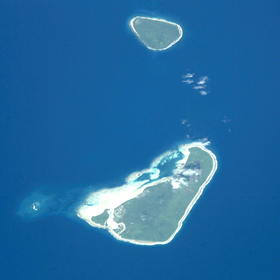Tafahi
| Tafahi | |
|---|---|

NASA picture of Niuatoputapu and Tafahi.
|
|
| Highest point | |
| Elevation | 560 m (1,840 ft) |
| Prominence | 560 m (1,840 ft) |
| Coordinates | 15°51′S 173°43′W / 15.850°S 173.717°W |
| Geography | |
| Location | Tonga |
| Geology | |
| Mountain type | Stratovolcano |
| Last eruption | Unknown |
Tafahi is a small (1.2 km × 2.8 km or 0.75 mi × 1.74 mi) island in the north of the Tonga archipelago, in fact closer to Savaiʻi (Sāmoa) than the main islands of Tonga. It is only 9 km (5.6 mi) north-northeast away from Niuatoputapu, and fishermen commute in small outboard motorboats almost daily between the two.
Other names for Tafahi are Cocos Eylant (coconut island) or Boscawen island.
Tafahi is a volcanic island and has the typical cone shape of a stratovolcano. The mountain is called Piu-ʻo-Tafahi (fanpalm of Tafahi) and is 560 m (1,840 ft) high. (The island, 3.42 km2 (1.32 sq mi), is smaller than Niuatoputapu, but higher). The soil is extremely suited for growing kava and vanilla, whose exports to the rest of Tonga and beyond is the main occupation of the population.
The harbour (merely an opening in the fringing reef, only passable by small boats) is at the northwest of the island. A steep staircase leads up to the village, with about 69 residents at the census of 2001, located on a plateau on the north side of the mountain. There is a government primary school.
It is told in local mythology that some naughty ʻaitu from Sāmoa one night wanted to steal the mountain of Niuafoʻou to bring it to Sāmoa. It started off well for them, they got the mountain, leaving Niuafoʻou behind with a big lake in its centre, and were dragging it through the sea, already halfway near Niuatoputapu. They had to hurry because ʻaitu law prescribed that they had to complete the work before sunrise.
But the fish god Seketoʻa saw them and did not like it. He ordered his matāpule (spokesmen) to cry as roosters, in the hope that the ʻaitu would think that dawn was close and they could as well give up. But it did not work, the ʻaitu were not ready yet to give up and only pulled harder. Then Seketoʻa himself acted. He swam in front of the ghosts, showing them his anus, which was red. The ghosts were frightened. They thought they saw the red sun rising and that it was already morning. They dropped the mountain and fled to Sāmoa. That is the reason that Tafahi is now where it is.
...
Wikipedia
